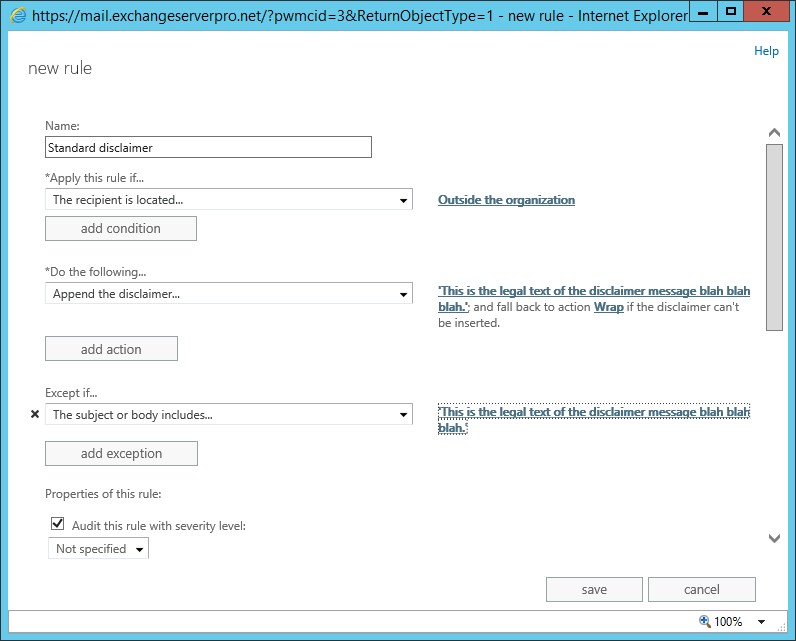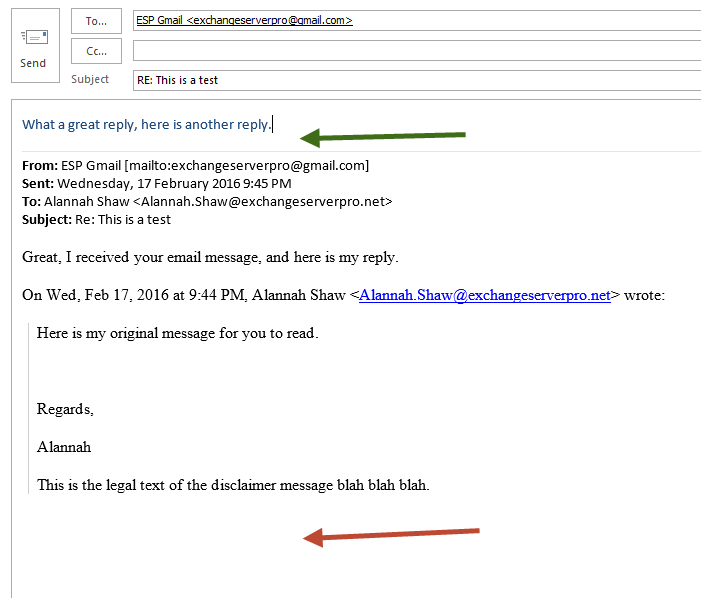Hamid asks:
We’re hosting Exchange 2010 and I set up a transport rule for a standard signature. It is working, but my problem is that once the email get sent, I see the signature on the sent emails. Also, when the email gets forward or replied, I see my signature on the bottom of the email, even though I’m not the one who started the email conversation.
Exchange Server and Exchange Online are capable of adding email signatures and disclaimer messages by using transport rules. As an example, here is how I would configure a disclaimer for all outbound email messages.

That rule will add the disclaimer text to the end of all outbound email messages, except if the text already exists (which is an exception I like to set to avoid multiple disclaimers being added to a long-running conversation that is going back and forth).
You could just as easily construct a standard email signature and use a transport rule to apply that instead.
They key point to understand here is that the transport rule will append your disclaimer of signature to the *end* of the whole email message. When the email is first sent, this is not a problem, because the end of the message is where you want it to be. But on forwards or replies, you would want the signature or disclaimer to appear at the end of the part of the message that you wrote, not the end of the whole message.
In other words, you’d normally prefer it to be inserted at the green arrow, not the red arrow.

This is a limitation of Exchange transport rules. The signature or disclaimer text can only be appended to the end of the whole message. Furthermore, transport rules will not update the sent items in user mailboxes, so the sent item will never contain the signature.
To insert the signature or disclaimer exactly where you want it to be, and also update sent items, you would need to use a third party product. There are several products that can do this for you, and that are easy to find in a Google search. Generally speaking, the market leaders are all make pretty good products, but I recommend you take advantage of their free trials to see which one suits your particular needs the best.



Just to clarify the limitation you have mentioned can actually be mitigated by using Regular Expressions in your exception. Instead of choosing subject or body includes any of these words, you would pick subject or body matches these text patterns and enter something like this: (of\sthe\sdisclaimer\smessage\sblah\sblah\sblah\.\s*)$
That would match only if the disclaimer was already at the very end of the message.
Pingback: Solving the Email Signature Problem for Exchange Mailbox Users – IT Tech Pro
Paul. I am using Exchange online. As you have mentioned, the rule will add the disclaimer text to the end of all outbound email messages, except if the text already exists to avoid multiple disclaimer.
The exception condition is not working that results in adding multiple disclaimer at the end. I have opened the case with Microsoft for this issue and the Microsoft engineer was able to reproduce the same issue and it was assigned to product engineering team now.
This is a perfect example of how bad the options are when it comes to transport rules. Imagine a scenario where a company rebrands and email primary changes and you must send a notice out that is professional but need something like a transport rule to prevent it from delivering per a court decision but you are allowed to retain the domain long enough to provide a professional response back for a customer. And you are limited by the amount of characters you can use. Ability to at least strip the sender out and notify the intended recipient “hey, we did our job and here is what happened”, to a professional operation of sending a daily report to managers you did this as well.
The hoops you have to jump through to change a primary SMTP domain in a onprem / Office 365 Hybrid mode for a new domain after the mailboxes have already migrated and all changes must be made on prem but the MX record for that and the prior domain hits a SPAM Cloud, disable archiving on the old domain, send it to 365 and your only option is a Transport Rule to block this domain and reply with a shortest message possible and the customer hoping you are getting the job done and few ways to prove it beyond sending from gmail to an account in the old domain to validate the transport rule is working and getting back a really unprofessional looking email that says this was the domain and now it is this? And that is one example.
Of all the things that must be accomplished to add a domain to an Exchange Organization, with AD and Exchange On-Prem but running in Hybrid-Mode, mailboxes already migrated to the cloud, new UPN, new SMTP alias, domain registration, managed DNS, adding the domain to Office 365, TXT records, SRV records (Skype for Business), then swapping out the existing primary to secondary, taking the secondary of first.last@newdomain.com, and on set date except mail from original primary SMTP domain, don’t deliver it, drop it, respond with a message. I have most of that scripted. That is the easy part. Notice how all of that is just a dependency to get on Exchange Online and use the Transport rule in the first place.
If you want to contribute and fix this… Take a look at this link below. And no, I’m not trying to intentional redirect you here and the site does require you sign up if not mistaken in full disclosure but this is where I’m published and help others. Microsoft is wasting my and the customers time with products like Yammer and Delve and other things that cause mass confusion if you enable them on the E3 license without a full fledged business plan and Transport Rules haven’t changed in years and the most optimal way to deal with certain scenarios and where on-prem you can buy thirdparty products you have lost all control once that migration batch says “Completed successfully”. This is a technology issue, industry wide. I know what I’m doing about it – what are you doing about it?
Me
https://www.linkedin.com/in/vcissgroup
https://www.experts-exchange.com/questions/29019440/New-SMTP-and-old-SMTP-Drop-old-SMTP-but-respond-with-custom-message-to-external-recipient-a-lot-more-Revised.html
In the Office 365 Exchange online I need to append html signatures on each reply or forwarded message, but the problem is that it appends only at the bottom of the old conversation messages and not inserting a new signature in the new replied or forwarded messages, is there any solution for this?
Like the article says, that’s the expected behavior.
4 years later same problem. Sad times
OMG 2022 and same issue
HI Guys
I need some help hear please, am not that clued up, I am new in the field.
Our disclaimer works fine on everybody expect for one specif user who signature is duplicated even on a new emails.
It would add four signatures at the bottom of the message sent by her. Check on her outlook found nothing
Please advise on how do I go troubleshooting this matter.
Regards
What have you used to implement the email signatures?
HI Paul
Transport Rule is used
Only one transport rule? Seems unusual to me that one rule would fire multiple times on a single message.
HI Paul
I might be not answering your question properly, as I said I am new I am new in th field,
I am told that it is suspected that multiple rules are wrongly applied to this user account, which I need to figure it out,
I think getting a way out to that would be helpful, in short I think I need to be able to view what rules are applied to this specific mailbox as emai are going out.
Please can you guide me how, we are on exchange 2013
If you have multiple transport rules that are applying signatures, then yes I would suspect that more than one rule is applying for that sender. You’ll just need to go into your transport rules (aka Mail flow rules) and inspect their conditions, and then look at the sender and try to determine why multiple rules are applying.
Dear Paul,
I have a simple question.
We added a disclaimer on our Exchange 2013 server.
How can we proof that we have send our disclaimer?
The customer could lie and say: sorry, I didn’t received your disclaimer.
Since the disclaimer does not show up in the send items of the employee I must have some kind of proof that the mail did had our disclaimer added by the server.
Friendly regards,
Pascal
Reply
I answered here:
https://www.practical365.com/exchange-2013-transport-rules/#comment-341597
Great post!
I am using this already and it is very helpful. The problem appears when some users use certificate to encrypt mails 🙂 Signature became attach file.
Could give your opinions for this case.
Regards
If you select “subject or body matches these text patterns” , it would be better for disclaimer.
Hi Paul,
quick question, in your experience does any of these 3rd party tools work with Exchange Online? Or are those only for on-prem environments?
Furthermore: will there ever be a way to do this directly from exchange or with MS tools? (Big fan of not using 3rd party software here)
Thanks!
Gabriele
There are third party tools that claim to work with Exchange Online. They’re easy to find. I haven’t used any of them myself, so you’ll need to do your own evaluation to see how well they perform.
Please help…how i stop inbound emails in which emails To and Cc does not exist my @domain.com.Because i have received majority of spam through Bcc emails.I think if i create such as rule i can stop spam in Bcc emails.
Thanks for the article.
This is an annoying problem we had to deal with recently. In the end, we felt it was best to go with a third party solution to make managing signatures a lot easier. We decided to go with Exclaimer so that we could have reply signatures and stop signatures flooding email conversations.
The fact that Exchange doesn’t have an HTML editor also meant, in my opinion, that Exchange is just too limited when it comes to email signatures. Suppose that is why there are third party tools in the first place.
Thanks for your contributions to the community, Paul.
Always love having to give this explanation to customers. They don’t like it but it is what it is. I will guide them to Exclaimer which has an on premise and hosted service to add really cool signatures where they need to be. Then, I refer to the old adage, “you get what you pay for”.
Here is an article I wrote if your viewers what to get fancy with their disclaimers… https://oddytee.wordpress.com/2014/06/18/customized-exchange-or-office-365-disclaimers/
Great article! I literally was just talking this over with management. They want to implement a new standard signature across the organization using Exchange. I tried to explain the limitations and the issues, but this article summed it up very well! I will be taking this to them as further proof that we either need to do this via some sort of deployment via group policies or a 3rd party tool.
Thank you for the awesome, perfectly timed article.